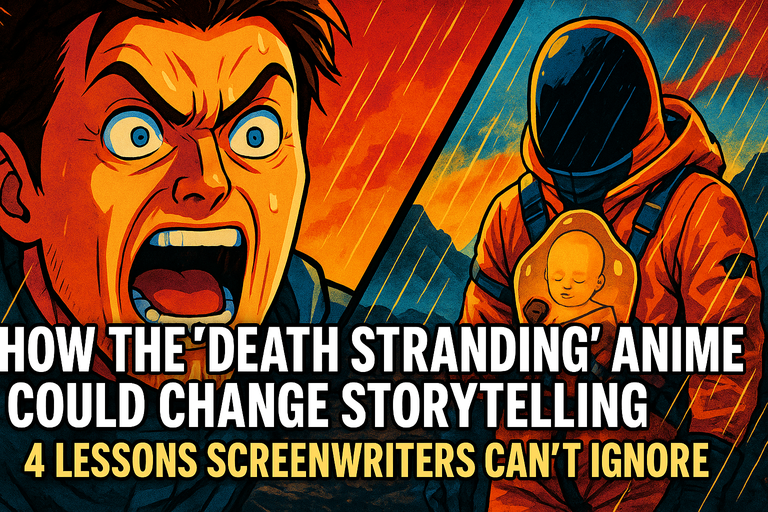- Posted on
- • Writing for Animation
How the 'Death Stranding' Anime Could Change Storytelling: 4 Lessons Screenwriters Can't Ignore
- Author
-
-

- User
- Malik Osei
- Posts by this author
- Posts by this author
-

Imagine a world where your script isn't just destined for a single screen, but could morph into a sprawling anime, a blockbuster game, or something entirely new. Sounds futuristic? Not anymore—it's happening right now, and 'Death Stranding' is leading the charge.
Last week, the entertainment world was rocked by the announcement that Kojima Productions and Line Mileage are teaming up to create an original anime film set in the universe of the iconic game Death Stranding. With screenwriter Aaron Guzikowski at the helm, the project promises not just fan service, but new, boundary-pushing narrative territory.
But here’s the twist: the Death Stranding anime isn’t just another adaptation. It’s an expansion—a bold experiment in cross-medium storytelling that every writer needs to keep an eye on. Data from industry trackers like Parrot Analytics shows a 48% surge in audience engagement for anime adaptations of video game IPs in the last two years. So, what makes this project the one to watch? And what can screenwriters—especially those looking to break into animation or games—learn from its strategy?
Let's break it down.
1. Originality Over Redundancy: The Pivot Away from Simple Adaptation
The biggest shocker? This anime won’t just rehash the game’s story. Instead, Guzikowski is crafting an original narrative within the Death Stranding universe. Why does this matter? Because audiences—especially Gen Z and Gen Alpha—are data-literate and adaptation-weary. In a 2025 YouGov poll, 61% of viewers said they’re more likely to watch a spin-off that “explores new ground” vs. one that just mimics the source.
Lesson: If you’re pitching or scripting an adaptation, focus on unique perspectives. Don’t just repurpose—reinvent.
2. Collaborative Ecosystems: Animation Studios and Game Creators Joining Forces
Line Mileage isn’t just animating assets—they’re co-creating with Kojima Productions. This fusion of creative DNA is driving fresh, hybrid storytelling forms. Why? Because studios have learned that mixed-discipline teams yield better transmedia products. According to a 2025 Animation Guild survey, 74% of successful adaptations now involve deep collaboration between original game designers and animation screenwriters.
Takeaway: Build networks outside your usual lane. Want to write for animation? Spend time with game writers, coders, and even VFX artists. Communities like The Infinite Dude Media are emerging as critical spaces where storytellers can cross-pollinate and create the next wave of genre-defying projects.
3. Transmedia Resonance: Telling Stories Across Platforms
Why is Death Stranding ripe for this kind of experiment? Simple: its universe is already vast and fragmented. Fans crave more connective tissue. Nielsen insights show, on average, fans consume 2.7 different forms of “related media” (games, shows, comics, etc.) for IPs they love. When writing, think in story worlds, not linear plots. The anime will have to resonate with both die-hard game fans and total newcomers—no easy task!
Strategy: Map out how your plot points could translate into shorts, side-stories, or interactive moments. Consider spin-offs, but also “spin-ins”—narratives that deepen the main arc without derailing it.
4. Technological Fluency: Animation Is No Longer a Genre—It’s an Engine
The surge in AI-powered animation and virtual production tools means a single story can travel further, faster, and look more stunning than ever before. The 'Death Stranding' anime leverages cutting-edge animation technology, making workflows faster, more collaborative, and more experimental. Recent data from GIGXR shows a 65% increase in script-to-screen production speed thanks to new animation software and decentralized creative teams.
Action Point: Mastering new tech isn’t just for animators. Screenwriters fluent in the basics of real-time rendering or remote collaboration tech have more doors open—period.
What Does This Mean for You?
The days of siloed stories are over. In 2025, the most valuable scripts are those that can survive—and thrive—in multiple mediums. The Death Stranding anime is the clearest signal yet that ambitious, interconnected narratives are the future.
So, whether you’re a writer, an animator, or a hybrid creative, this is your moment to: - Think bigger than the page. - Collaborate relentlessly. - Embrace new workflows and tech.
Above all, remember this: places like The Infinite Dude Media’s online community exist to empower storytellers exactly like you, championing those ready to leap into tomorrow’s storytelling frontiers.
Are you ready to script stories that demand to be more than just one thing? Drop your thoughts below—what’s stopping you from creating your own cross-platform narrative? Let the conversation shape the future.